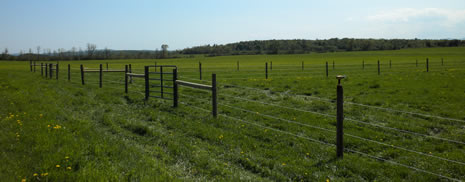
Cattle Fencing: Woven Wire Fencing, Barbed Wire Fencing &
Hi-Tensile Fencing to Contain and Safegurd Your Herd
There are many different fencing options for containing your cattle, as well as many factors in choosing the right fence. Homestead Fence most often recommends using either woven wire fencing, barbed wire fencing, or hi-tensile fencing to contain your cattle. The type of cows you have may determine the best fencing for your needs. As not all cows are the same, we take into account how aggressive the animals are when building a fence for their containment. For example, Jersey cows are sometimes contained with only one or two strands of electrified hi-tensile wire, whereas bulls may require board fence with electric offsets to discourage them from rubbing on the fence. The wire spacing that Homestead Fence uses most of time is 16 to 25 foot to keep the post tight to ensure the strength of the wire to resist a cow pushing on the fence.


Although woven wire fencing is relatively expensive it offers a strong physical barrier and the fence doesn't need to be energized. Newer hi-tensile wires can be installed and little stretching or sagging occurs. Hi-tensile fencing is relatively cheap in comparison to other livestock fencing options. Posts can be spaced 16 to 60 feet apart, reducing installation costs, and there are options to run one to seven strands of the wire, depending on your fencing needs. Hi-tensile fencing must be electrified and it does require removing of brush to keep the fence line clear. Barbed wire fencing required no energy, and newer hi-tensile options do not stretch like old carbon wire. Barbed wire fencing might be best used where it's difficult to keep a fence energized. It is only suitable for cattle and may not contain beef cattle. It is also not recommended for horses or in neighborhoods with pets and children.
